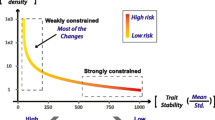Abstract
The Darwinian theory of life evolution is capable of explaining the majority of related phenomena. At the same time, the mechanisms of optimizing traits beneficial to a population as a whole but not directly to an individual remain largely unclear. There are also significant problems with explaining the phenomenon of punctuated equilibrium. From another perspective, multiple mechanisms for the regulation of the rate of genetic mutations according to the environmental stress have been discovered, but their precise functional role is not well understood yet. Here a novel mathematical paradigm called a Kinetic-Force Principle (KFP), which can serve as a general basis for biologically plausible optimization methods, is introduced and its rigorous derivation is provided. Based on this principle, it is shown that, if the rate of random changes in a biological system is proportional, even only roughly, to the amount of environmental stress, a virtual force is created, acting in the direction of stress relief. It is demonstrated that KFP can provide important insights into solving the above problems. Evidence is presented in support of a hypothesis that the nature employs KFP for accelerating adaptation in biological systems. A detailed comparison between KFP and the principle of variation and natural selection is presented and their complementarity is revealed. It is concluded that KFP is not a competing alternative, but a powerful addition to the principle of variation and natural selection. It is also shown KFP can be used in multiple ways for adaptation of individual biological organisms.
Similar content being viewed by others
References
Agur Z, Mazor G, Meilijson I (1991) Maturation of the humoral immune response as an optimization problem. Proc R Soc Lond B 245: 147–150
Caporale LH (2000) Mutation is modulated: implications for evolution. BioEssays 22: 388–395
Darwin C (1859) On the origin of species by means of natural selection, or preservation of favored races in the struggle for life. Murray, London
Dunn-Walters DK, Edelman H, Mehr R (2004) Immune system learning and memory quantified by graphical analysis of B-lymphocyte phylogenetic trees. BioSystems 76: 141–155
Eisenbach M (2004) Chemotaxis. Imperial College Press, River Edge, NJ
Eldredge N, Gould SJ (1972) Punctuated equilibria: an alternative to phyletic gradualism. In: Schopf TJM (eds) Models in paleobiology. Freeman, San Francisco
Fisher RA (1930) The genetical theory of natural selection. Oxford University Press, Oxford, UK
Foster PL (2000) Adaptive mutation: implications for evolution. BioEssays 22: 1067–1074
Foster PL (2007) Stress-induced mutagenesis in bacteria. Crit Rev Biochem Mol Biol 42: 373–397
Futuyma DJ (1998) Evolutionary biology. Sinauer Associates, Inc., Sunderland, Massachusetts
Gould SG (2002) The structure of evolutionary theory. The Belknap Press of Harvard University Press, Cambridge, Massachusetts
Hoffman AA, Parsons PA (1991) Evolutionary genetics and environmental stress. Oxford University Press, Oxford
Hull DL (1982) The naked meme. In: Plotkin HC (eds) Learning, development, and culture. Wiley, Chichester
Kepler TB, Perelson AS (1995) Modeling and optimization of populations subject to time-dependent mutation. Proc Natl Acad Sci 92: 8219–8223
Lenski RE, Ofria C, Pennock RT, Adami C (2003) The evolutionary origin of complex features. Nature 423: 139–144
Liu Y-J, Joshua D, Williams G, Smith C, Gordon J, MacLennan ICM (1989) Mechanism of antigen-driven selection in germinal centers. Nature 342: 929–931
Lucht JM, Mauch-Mani B, Steiner H-Y, Metraux J-P, Ryals J, Hohn B (2002) Pathogen stress increases somatic recombination frequency in Arabidopsis. Nat Genet 30: 311–314
Mao EF, Lane L, Lee J, Miller JH (1997) Proliferation of mutators in a cell population. J Bacteriol 179: 417–422
McClintock B (1984) The significance of responses of the genome to challenge. Science 226: 792–801
Metzgar D, Wills C (2000) Evidence for the adaptive evolution of mutation rates. Cell 101: 581–584
Nagylaki T (1992) Introduction to theoretical population genetics. Springer-Verlag, New York
Neuberger MS, Milstein C (1995) Somatic hypermutation. Curr Opin Immunol 7: 248–254
Paul WE (1993) Fundamental immunology. Raven Press, New York
Prosser CL (1986) Adaptational biology. Wiley, New York
Rice SH (2004) Evolutionary theory: mathematical and conceptual foundations. Sinauer Associates, Inc., Sunderland, Massachusetts
Rosenberg SM (2001) Evolving responsively: adaptive mutation. Nat Rev Genet 2: 502–515
Shimansky YP (2007) Role of optimization in simple and learning-based adaptation and its biologically plausible mechanisms. In: Williams TO (eds) Biological cybernetics research trends. Nova Science Publishers, NY, pp 95–164
Shimansky YP (2009) Biologically plausible learning in neural networks: a lesson from bacterial chemotaxis. Biol Cybernet 101: 379–385
Smith JM (1987) How to model evolution. In: Dupré J (eds) The latest on the best. MIT Press, Cambridge, MA
Sniegowski PD, Gerrish PJ, Lenski RE (1997) Evolution of high mutation rates in experimental populations of E. coli. Nature 387: 703–705
Sniegowski PD, Gerrish PJ, Johnson T, Shaver A (2000) The evolution of mutation rates: separating causes from consequences. BioEssays 22: 1057–1066
Williams GC (1966) Adaptation and natural selection. Princeton University Press, Princeton, NJ
Winter DB, Gearhart PJ (1998) Dual enigma of somatic hypermutation of immunoglobulin variable genes: targeting and mechanism. In: Somatic hypermutation of immunoglobulin genes, vol 162 of Immunological reviews. Munksgaard, Copenhagen
Ziegner M, Steinhauser G, Berek C (1994) Development of antibody diversity in single germinal centers: selective expansion of high-affinity variants. Eur J Immunol 24: 2393–2400
Author information
Authors and Affiliations
Corresponding author
Rights and permissions
About this article
Cite this article
Shimansky, Y.P. Adaptive force produced by stress-induced regulation of random variation intensity. Biol Cybern 103, 135–150 (2010). https://doi.org/10.1007/s00422-010-0387-5
Received:
Accepted:
Published:
Issue Date:
DOI: https://doi.org/10.1007/s00422-010-0387-5




